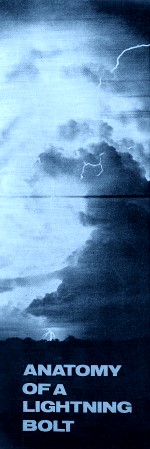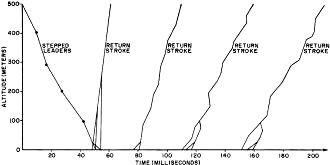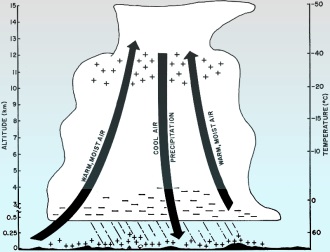Anatomy of a Lightning Bolt
|
|
Mankind has been fascinated with - and scared of - lightning since the dawn of civilization. It's incredible power has been the cause of much property destruction and loss of life. Benjamin Franklin famously proved that lightning is in fact a form of electrostatic discharge (he didn't "invent" electricity). Mr. Franklin exploited that knowledge to invent grounded lightning rods for tall buildings, thereby nearly totally halting the lightning-caused fire epidemic in Philadelphia's and other cities' tallest wooden-framed buildings. Much investigation and implementation of lightning discharge mitigation schemes has occurred to safeguard against those catastrophic events. Ultimately, though, says author David Heiserman in this 1973 Popular Electronics magazine article, "Lightning has no sympathy for the feeble electrical schemes of civilized man." Anatomy of a Lightning Bolt : The world's spectacular electrical show produces a staggering amount of energy
You probably witness the world's largest and most spectacular electrical show several times a year. Under a curtain of black clouds and in the company of heavy rain and high winds, nature winds up her giant electrical dynamo, releasing bolts of blue-white electrical energy that have terrified, mystified, thrilled, and troubled mankind. Nature puts on her world-wide lightning show about 1800 times a day. The output of electrical energy is staggering - about 350 kW-hr per bolt, which amounts to 1015 kW-hr annually. If there were some way to harness all this power, it could supply the world's growing demand for electrical power for at least the next 300 years. In comparing lightning to manmade electricity, it is interesting to note that the average going rates for electrical power would put a price tag of $10 on each bolt. All told, the annual operating budget for nature's giant electrical show would be on the order of $ 25-trillion. Lightning has no sympathy for the feeble electrical schemes of civilized man. It is especially troublesome to highly developed nations that rely heavily on long-distance power transmission and electronic communications. Lightning has a way of immobilizing and blacking out communications for whole communities. Although modern lightning protection techniques have reduced the number and duration of total power outages due to lightning, the outages that do occur have more disastrous effects than ever before. Engineers and scientists have developed lightning rods, arrestor schemes, and fast-acting bypass switches to reduce the ways lightning can destroy outdoor structures and sensitive electrical equipment. Frequency- and pulse-modulation techniques are partial answers to the problem of carrying on radio communication through the world's constant thunderstorm activity. But lightning still manages to pull off some surprises. NASA engineers, for example, thought they had a good lightning protection system for spacecraft until a bolt struck Apollo 13 seconds after takeoff. So scientists and engineers still have much to learn about lightning in general. By studying the behavior of devastating cloud-to-ground discharges, they hope to find improved ways of eliminating the destructive effects. By studying the atmospheric mechanisms responsible for generating the charges in the first place, they may find ways to dissipate thunderstorms before they reach maturity. Cloud-to-Earth Damage. Only a small fraction of electrical equipment disabled or destroyed by lightning is the victim of a direct "hit." In most cases, the damage is due to currents and voltages induced by a nearby lightning stroke. The intense magnetic and static fields set up by a bolt can crush steel conduit, fuse long wires, and send surges of electrical energy through conductors to sensitive electrical equipment. In one case, a stereo buff had strung long wires to a pair of speakers mounted near a backyard patio. A nearby lightning stroke induced currents into the wires, blowing the speakers out of their enclosures and burning out the components in the output stages of his amplifier. The amplifier was inside the house; so, it was fortunate that the interconnecting wires disintegrated before setting the house afire. The moral? Use grounded shielded cable for outdoor speakers. Fig. 1 - Diagram of electrical and mechanical structure of a typical thunderstorm cell shows positive charges at top, negative at bottom. What makes indirect lightning effects even more perplexing is the fact that electrical equipment sometimes burns out even when there has been no lightning in the immediate vicinity. Thunderclouds carry extremely large electrical charges and can act as one plate of a giant capacitor. The air directly below the cloud serves as a good dielectric, while the earth and objects attached to it act as the opposite plate. A highly charged thundercloud moves along, dragging a "shadow" of charges along the earth below. The moving charges gather around ungrounded objects and produce field strengths that can run as high as 10,000 volts/meter in a vertical direction. This accounts for the eerie corona discharge, or "St. Elmo's Fire," sometimes visible on tall masts and antennas just before a storm arrives. When a lightning bolt suddenly discharges this giant capacitor, the charges surge along the earth for several kilometers (1 km = 5/8 mile) toward the point of discharge. Any ungrounded conductor lying perpendicular to the path of these moving charges can serve as the armature in a giant electrical generator; and it is often possible to see a continuous arc across gap-type lightning arrestors when a storm is as much as 5 km away. Low-impedance grounding cables can eliminate most of the effects of St. Elmo's Fire. But in the case of antennas and power lines that cannot be directly grounded, the gap-type lightning protectors allow some voltage build-up to occur. The only way to suppress this kind of gap potential is by adding special bypass circuits to the input or output stages of equipment attached to the towers. Modern grounding techniques have all but eliminated serious damage by direct hits to towers and tall buildings. No grounding system is perfect, however, and the small impedance that remains between the tip of a tower and the earth still invites a direct lightning hit during a very heavy storm. Even though the grounding scheme permits the full blast of lightning current to flow to ground without doing serious damage, the IR drop along the current path can produce some devastating and unpredictable high-voltage flashover effects. High-voltage flashover does not pack the punch of a direct hit, but it often originates near the ground - far below the lightning rods and arrestors intended to protect the system from overhead sources of high voltage. Creating a lightning Bolt. About 200 years ago, Benjamin Franklin demonstrated that lightning is a form of electrical energy. The mechanism for generating the electrical charges, however, is still imperfectly understood since it involves moving air currents, temperature and air pressure changes, and formation of all kinds of precipitation. So, the following generalized theories apply to about 90 percent of lightning events studied; the remaining 10 percent represents what is not yet understood, accounting for most of the surprises. Lightning forms in a vast atmospheric thunderstorm "cell." Unless at least one cell exists, there can be no lightning. It is possible for a single thunderstorm to have as many as five cells at one time. An infant cell begins to form whenever a localized updraft of warm, moist air moves faster than 8 meters/second. When this air reaches an altitude of 10-12 km, it expands and cools to form supercooled water droplets (water that still exists in a liquid state be-tween -20° C and -40° C). The heavier droplets of supercooled water remain at this altitude, while the lighter ones move up to about 15 km where they freeze at -50° C and form the "anvil head" that typifies a fresh thundercloud. As the droplets of supercooled water merge and form heavier drops, they freeze into hailstones and begin falling against the updraft. The falling precipitation sets up weak downdrafts of cool air that force even more hailstones, sleet, and snow to form. If prevailing weather conditions are just right, the cool precipitation and downdraft avalanche into a tunnel of air moving earthward at about 8 m/s. The tunnel of cool air pinches the warmer updrafts into a smaller space, increasing the updraft velocity to about 20 m/s and creating a cycle of violent air flow that typifies a mature thunderstorm cell. The cell exists only as long as there is an adequate supply of warm air from the earth below. When the supply is exhausted, the cell dies away, and the anvil-head cloud breaks up. A typical cell lasts about 30 minutes. The most widely accepted theory of how electrical charges form in a thunderstorm cell depends upon the peculiar electrical behavior of violent collisions between droplets of supercooled water and hailstones. Scientists have shown in laboratory experiments that supercooled water droplets colliding with somewhat warmer and larger chunks of ice tend to splatter into even smaller particles that almost instantly freeze. More important is the fact that these tiny freezing particles take on positive electrical charges, leaving the ice with a somewhat negative charge. In an actual thunderstorm cell, the positively charged ice particles are so light that updrafts keep them suspended near the top of the cloud. The heavier hailstones fall earthward, carrying their negative charges with them. As these hailstones pass through the 0° C point, they begin to melt, leaving a trail of negatively charged water droplets behind. Most thunderclouds, then, accumulate positive charges near their tops and negative charges near the bottom (see Fig. 1). Fig. 2 - Sequence of electrical events that occur for a typical lightning bolt shows downward stepped leaders and the bright return strokes. On a normal clear day, the surface of the earth has a negative electrical charge with respect to the air above. Tests show that clear-day fields increase with altitude at about 120 V/meter. However, whenever a thundercloud passes over the earth, the negative charge on the cloud reverses the polarity on the earth's surface below it. Consequently, the earth takes on a positive potential that can rise as high as 10,000 V/meter under the middle of the cell for a radius of about 10 km. Since the bottom of the cloud has the opposite charge, it sets the stage for a mammoth electrical discharge. A lightning discharge between cloud and earth is not caused by an instantaneous electrical breakdown of the intervening air. The breakdown potential of air is on the order of 10 kV/cm, whereas the charge between a thundercloud and the earth seldom exceeds 100 V/cm. The ultimate breakdown actually takes place in a series of steps that begin at a point near the bottom of the cloud. When the potential difference between a cloud and the earth reaches a critical point, a dense corona discharge appears at a spot on the bottom of the cloud. Since in the corona the charges are negative, the positive potential on the earth pulls it downward to form a long "tunnel" of highly conductive plasma (ionized' gases). This tunnel. called a "leader," can be 10-200 meters long and about 12 cm in diameter. After an interval of 10-100 μs, the leader stabilizes and another develops from its bottom tip, channeling negative charges another 100 meters or so toward the earth. This process repeats until the chain of leaders reaches to within 5-50 meters of positively charged objects on the earth, at which point the positive coronas on the earth-bound objects rush up to meet the lowest leader to complete the conductive path between cloud and earth. Typical stepped leaders carry about 1000 amperes of current. The tunnel gives off very little light except at the very tip where it is pushing its way through freshly ionized air. Traveling downward at an average velocity of 105 meters/s the leaders touch ground within about 20 ms. Without the help of special cameras, it is practically impossible to see a stepped leader develop. Once the plasma tunnel between the cloud and the earth is complete, the main discharge energy bursts upward at about a tenth the velocity of light. The plasma carries 10-100 kA of current, and light from the highly agitated ions in the tunnel is quite intense. This phase of the lightning discharge cycle is known as the "return stroke." For most of us, this pyrotechnic display is what lightning is all about. (See Fig. 2). The dramatic return stroke lasts about 100 μs, or just long enough to neutralize the charges around the ends of the tunnel. However, the tunnel can remain highly conductive for several milliseconds after the return stroke is over and can move several meters to points on the cloud and surface of the earth where pockets of charges still exist. Hence, several return strokes can occur after a single stepped leader paves the wav. On the average, a single plasma channel carries three return strokes, separated by about 30 ms so that an observer appears to see the lightning bolt flicker. When there are no longer any return strokes, the winds destroy the tunnel by scattering the conductive ions. If weather conditions are right, though, nature's dynamo needs only about 20 seconds to recharge and get another leader started earthward.
Posted March 13, 2023 |
|

 By David L. Heiserman
By David L. Heiserman 
